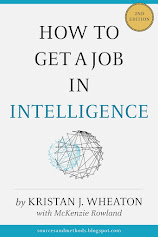The fundamental question for an intelligence analyst is, "What do I think is likely to happen?" Analytic confidence, on the other hand, answers the question "How likely is it that my answer to the first question is incorrect?"
I have argued that intelligence analysts need to answer both of these questions to have a theoretically complete intelligence estimate -- an estimate that is as transparent as possible to the decisionmaker the intelligence analyst supports.
Tristan de Frondeville, in his article for Edutopia called Ten Steps To Better Student Engagement, makes a similar case -- and for surprisingly similar reasons -- when it comes to assessing a student's work.
While Frondeville's article is about a variety of techniques for increasing student engagement in learning (and well worth the read), the part that caught my eye was about halfway down, labelled with the subtitle: Teach Self Awareness About Knowledge. De Frondeville uses the little graphic (which he designed) at the left with all of the questions on his tests. De Frondeville writes, "After the students answer a question, have them place an X on the line to represent how sure they are that their answer is correct. This approach encourages them to check their answer and reflect on their confidence level. It is informative when they get it wrong but marked "for sure" or when they do the opposite and mark "confused" yet get the answer right." This approach is also remarkably similar to the approach developed (independently) by Josh Peterson for use in his thesis on the appropriate elements of analytic confidence.
De Frondeville uses the little graphic (which he designed) at the left with all of the questions on his tests. De Frondeville writes, "After the students answer a question, have them place an X on the line to represent how sure they are that their answer is correct. This approach encourages them to check their answer and reflect on their confidence level. It is informative when they get it wrong but marked "for sure" or when they do the opposite and mark "confused" yet get the answer right." This approach is also remarkably similar to the approach developed (independently) by Josh Peterson for use in his thesis on the appropriate elements of analytic confidence.
For both the analyst and the student, the purpose is largely the same -- to give as complete a picture as possible with regard to their current understanding of a topic. Both students and analysts who indicate a low confidence score are signalling that, while they might get the answer "right", that may well be due to luck as their perception is that one or more of the factors commonly associated with analytic or educational confidence is missing.
From an educational standpoint, it makes an enormous amount of sense. It not only teaches self-reflection/awareness and critical thinking but also provides the teacher with crucial information about a student's own perception of their progress. Taken individually, the additional information allows a teacher develop a more complete assessment of a student's learning. Taken in aggregate, the results could help rapidly identify areas in a lesson plan that need more or less attention.
I intend to try it as soon as possible in my courses. If anyone else gives it a try (or has already tried a similar method), please drop a comment here about your experience.
Monday, March 16, 2009
Extending The Concept Of Analytic Confidence Into The Classroom (Edutopia)
Posted by
Kristan J. Wheaton
at
12:36 PM
![]()
Labels: education, intelligence, Resource, teaching techniques
Subscribe to:
Post Comments (Atom)






No comments:
Post a Comment